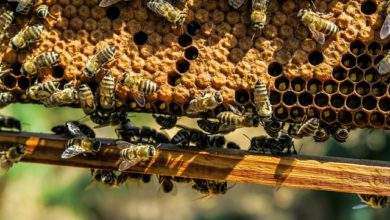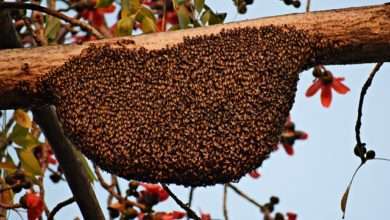Honeybee Flight Path

When it comes to pollinating flowers, they are essential to the state of our ecosystem.
Each year, bees fly hundreds of thousands of miles searching for nectar and pollinating flowers. In this article, we will explore the honeybee flight path, how they navigate and communicate with each other, and why their role is so important in our world.
Honeybee Navigation
Honeybees are remarkable creatures known for their distinctive black and yellow striped bodies and their important role in pollination. However, what sets them apart from other insects is their incredible navigational skills.
The ability of honeybees to navigate and find their way back to their hives from miles away has fascinated scientists for years. In this chapter, we will discuss the different factors that influence honeybee flight path and shed light on how they navigate.
How do honeybees navigate?
Honeybees are able to navigate using a combination of different sensory cues. They rely on visual cues, such as landmarks and the position of the sun in the sky. They also use their sense of smell to follow pheromone trails left by other bees.
Additionally, they have an internal compass that is sensitive to the Earth’s magnetic field. By combining these different cues, honeybees are able to navigate with precision.
What factors influence Honeybee Flight Path?
There are several factors that influence the flight path of honeybees. One of the most important factors is the location of the flowers they are visiting.
Honeybees tend to follow the shortest possible route to and from their hives, which means that their flight paths are heavily influenced by the distribution of flowers in the surrounding area. This is why you will often see large numbers of honeybees around flowering plants and trees.
Other factors that can influence honeybee flight path include weather conditions and the time of day. Honeybees are more likely to fly in windy conditions if it means they can take advantage of tailwinds to make their flight easier. They are also more likely to forage during the daytime when the flowers they visit are most likely to be open and accessible.
What role do honeybees play in pollination and ecosystem management?
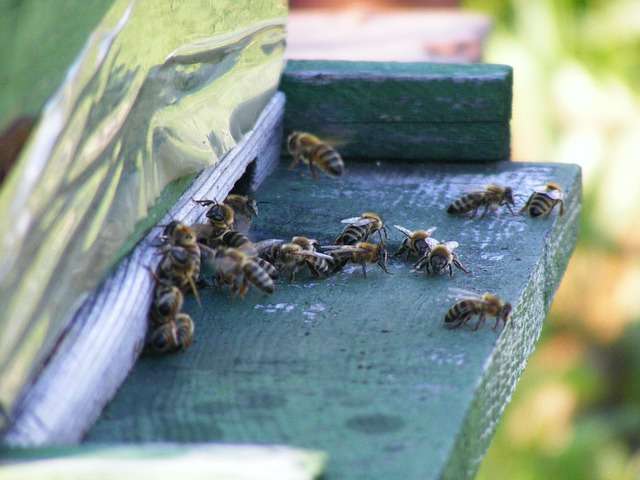
Honeybees play a critical role in pollination, which is the process by which flowers are fertilized and produce seeds. Without honeybees, many plants would not be able to reproduce, which would have a devastating impact on the ecosystem. Honeybees also help to maintain biodiversity by transferring pollen between different plants and trees, which helps maintain healthy ecosystems.
In addition to their role in pollination, honeybees are also important in ecosystem management. They are used to pollinate commercially grown crops, such as almonds and blueberries, and are essential to the production of honey. They also play an important role in maintaining the health of wild bee populations by cross-pollinating wild flowers and plants.
By understanding how they navigate and what factors influence their flight path, we can gain a greater appreciation for these important pollinators and their role in maintaining healthy ecosystems.
The Honeybee “Waggle Dance”
Honeybees also communicate with each other using a behavior known as the “waggle dance.” This intricate dance involves the bee wiggling its body back and forth while moving in a figure-eight pattern.
The waggle dance is a form of communication used by honeybees to share information about the location of nectar sources. The dance is performed by worker bees inside the hive, using a series of movements and sounds.
How does the waggle dance help honeybees communicate?
The waggle dance provides detailed information about the location of nectar sources, including distance, direction, and quality of the nectar. By performing the dance, bees are able to share information with other bees in the hive and recruit them to visit the same flowers.
How do honeybees translate the dance into directions for other bees?

Honeybees are able to translate the waggle dance into directions by sensing the movements and sounds made by the dancer. The angle of the dancer’s body and the duration of the waggle indicate the direction and distance of the nectar source. The intensity and frequency of the waggle indicate the quality of the nectar.
How do scientists observe and study the waggle dance?
Scientists are able to observe and study the waggle dance by using special video cameras and tracking software that can detect and record the movements of individual bees. They are also able to manipulate the dance by altering the position of the flowers, and then observe how the bees respond and adjust their dance to reflect the new information.
Honeybee Navigation and Communication
Honeybees fascinate us with their complex social organization, dance communication, and navigational abilities. Their complex communication system and navigation techniques are part of their survival strategy. The honeybees communicate with one another about food sources, and it all depends on their amazing navigation and communication skills.
Bees are social insects that live together in a colony which is composed of three castes, the queen, worker bees and drones. Worker bees are the ones responsible for foraging for nectar, pollen, and water to bring back to the colony, while drones mate with the queen.
The honeybee flight path is an essential aspect of foraging. Bees use landmarks, the position of the sun, and the Earth’s magnetic field to navigate. They communicate the location of the food source to other bees through their dancing, but they must also navigate back to the hive.
The flight path taken by foraging bees is generally in a zigzag pattern, and they use landmarks such as trees or buildings to help navigate back to the hive. It is an intricate process that requires precision and constant awareness of the surroundings.
Without their navigational skills, honeybees would not be able to find their way back to the hive and would not be able to provide food for their colony.
Can honeybees adjust their flight path based on environmental cues?
The answer is yes. Bees can adjust their flight path based on environmental cues such as changes in wind direction and intensity, temperature, and precipitation. Bees are also sensitive to the Earth’s magnetic field and use it as a kind of compass to navigate.
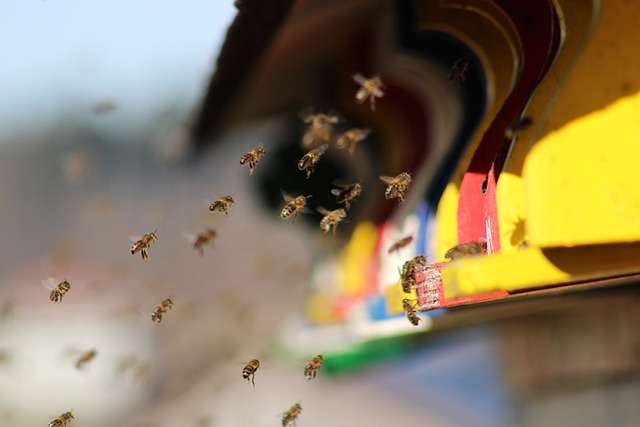
They can also adjust their dance communication to account for changes in the location of the food source. If the food source moves, they will change the direction of their dance to reflect the new location.
Conclusion
Honeybee flight path is a remarkable feat of nature. These tiny insects are able to navigate their surroundings using a combination of visual cues, magnetic fields, electrostatic energy, and communication with other bees.
They play a vital role in our ecosystem, and without their existence, our world would be a vastly different place. It’s essential that we take steps to protect and support these remarkable creatures, ensuring that their populations continue to thrive for generations to come.
FAQ
What is a honeybee flight path?
- A honeybee flight path is the route taken by honeybees when they are foraging for nectar and pollen. It is a complex pattern that is determined by the location of the food source and the surrounding environment.
How do honeybees navigate their flight path?
- Honeybees navigate their flight path by using a combination of visual cues and odors. They are able to recognize specific landmarks and can also detect changes in the scent of their surroundings to help them find their way back to the hive.
How far can honeybees travel on their flight path?
- Honeybees can travel up to three miles from their hive in search of food. However, they will typically stay within a radius of one to two miles around their hive.
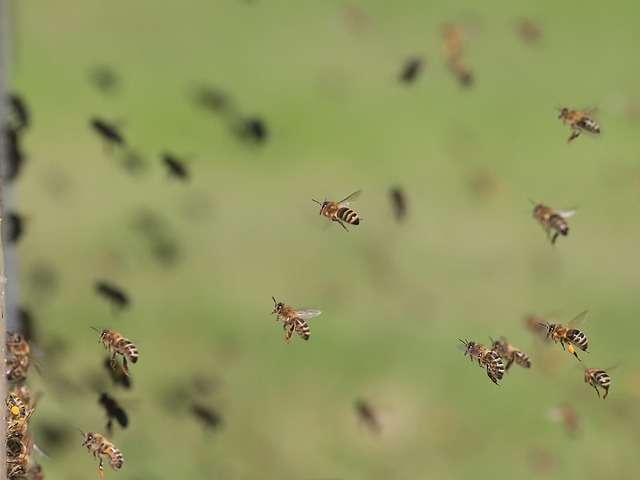
How important is honeybee flight path to the overall health and productivity of a hive?
- Honeybee flight path is crucial to the health and productivity of a hive. It allows bees to forage for food and bring it back to the hive to feed the colony. Without an efficient flight path, the hive would not be able to survive.
Are honeybees affected by environmental factors such as weather and seasonality when flying?
- Yes, honeybees are affected by environmental factors such as weather and seasonality. They are more active in the spring and summer months when there is an abundance of flowers to forage on. They are also affected by cold temperatures and rain, which can limit their ability to fly.
Can honeybee flight paths be disrupted by human activity?
- Yes, honeybee flight paths can be disrupted by human activity. This can be caused by the destruction of natural habitats, the use of pesticides, and other factors that can make it difficult for bees to navigate their surroundings.
How can beekeepers help ensure that honeybee flight paths remain intact and healthy?
- Beekeepers can help ensure the health and vitality of honeybee flight paths by providing a diversity of plants for bees to forage on, avoiding the use of pesticides and other harmful chemicals, and creating a safe and healthy environment for bees to thrive.
